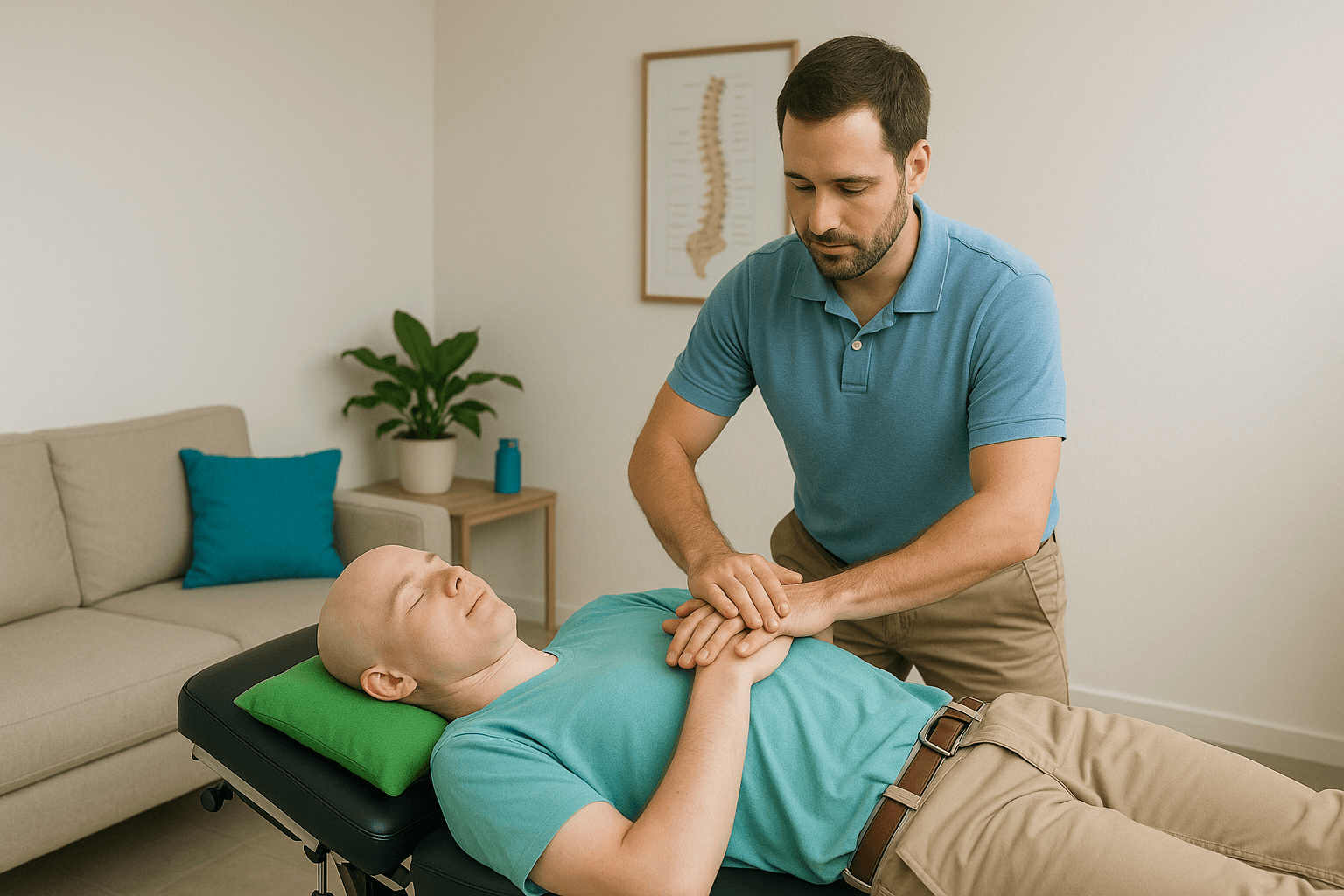When we talk about serious illnesses that affect the brain and nervous system, most people think of conditions like ALS or multiple sclerosis. But there’s another, much rarer condition called Krabbe Disease—and if you’ve never heard of it, you’re not alone.It’s a tough illness.
It’s often fatal, and there’s no cure. But this story is about a woman who lived with Krabbe Disease for years and saw her life change for the better after starting a very specific kind of chiropractic care called Advanced BioStructural Correction™ (ABC™).
Jump to:
TLDR – Quick Guide
- The Disease: Adult Onset Krabbe Disease is a progressive and fatal neurological disorder with no known cure.
- The Symptoms: Chronic migraines, loss of balance, weakness, and nerve pain.
- The Patient: A 57-year-old woman who had suffered for decades with no relief from conventional treatments.
- The Breakthrough: After starting Advanced BioStructural Correction™ (ABC™) care, her migraines vanished, her balance improved, and her quality of life skyrocketed.
- The Outcome: She’s now 70, still functioning independently with fewer symptoms—crediting ABC™ with extending and improving her life.

What Is Krabbe Disease?
Krabbe Disease (also called Globoid Cell Leukodystrophy) is a rare genetic condition that affects the nervous system. Most people are diagnosed as babies, but a small number—about 10% of cases—start later in life. This is called Adult Onset Krabbe Disease.
Here’s what happens:
- Your nervous system is coated in myelin, which works like insulation around electrical wires.
- In Krabbe Disease, the body can’t produce enough of a certain enzyme called GALC.
- Without this enzyme, a toxic substance called psychosine builds up.
- This damages the cells that make myelin, leading to nerve damage, muscle weakness, and eventually loss of movement.
People with adult-onset Krabbe often develop:
- Numbness or burning sensations in arms and legs
- Loss of balance and coordination
- Vision and hearing problems
- Weakness, stiffness, or paralysis
- Chronic pain and migraines
It’s progressive, meaning it gets worse over time, and sadly, it’s life-limiting.
Meet the Patient
The woman in this case report was 57 years old when she started ABC™ chiropractic care. She had a long history of health issues:
- Migraines so severe they made her vomit (happening every month for 18 years!)
- Chronic neck and back pain
- Poor balance and frequent falls
- Nerve pain and weakness
- An official diagnosis of Adult Late Onset Krabbe Disease in 2020
She’d tried all sorts of treatments—physiotherapy, exercise programs, fascia therapy, and even cranial treatments—but nothing gave lasting relief. In fact, some things made her worse.
By the time she started chiropractic care, she was struggling to walk normally and often felt “drunk” because her balance was so bad.
The Chiropractic Approach
Her chiropractor used Advanced BioStructural Correction™—a technique that focuses on fixing specific spinal misalignments the body can’t correct by itself.
ABC™ aims to:
- Improve posture naturally
- Reduce tension and “stretch” on the nervous system
- Help the body work more efficiently
She started seeing her chiropractor twice a week. At first, the main goals were simple:
- Stop the migraines
- Reduce neck pain
- Help her stand and move better
- Improve balance and prevent falls
The Results
The changes didn’t happen overnight, but they were life-changing:
- Migraines stopped completely. Within six months, the monthly migraine-and-vomiting episodes she’d had for 18 years were gone—and they never came back.
- Posture improved. Photos and X-rays showed her head and spine were sitting in a much more upright, balanced position.
- Neck pain reduced. She reported much less discomfort day-to-day.
- Balance got better. At one point, her chiropractor changed the “breakdown side” of her adjustment, and she said it almost instantly solved her falling problem.
- Quality of life skyrocketed. She could function better, move with more confidence, and keep doing the things she enjoyed.
She’s now 70 years old, still getting regular ABC™ adjustments, and still reports feeling better after every session. Even though there’s no cure for Krabbe Disease, she says this care has slowed her decline and helped her stay independent for much longer than expected.
Why This Might Work
There’s a theory that when the body is stuck in a slumped, forward-flexed posture, it creates tension on the nervous system—almost like stretching an electrical wire. This “stretch” can make nerve signals less efficient.
ABC™ works to remove forward misalignments in the spine, helping the body stand more upright. This may reduce tension on the nervous system, improving how nerves communicate.
For someone with a neurodegenerative disease like Krabbe, where the nervous system is already under attack, reducing this extra stress could help preserve function and slow down symptoms.
The Patient’s Own Words
Here’s what she said about her journey:
“ABC has been a life-rope at a time I was ready to give up. ABC was my last option and did not fail me. I made slow, but remarkable improvements. I didn’t know until 2020 that I had Krabbe, a metabolic disease that creates a neurotoxin that builds up in each cell and in the brain. I consider ABC one of the main reasons why I’ve been able to function from 2011 until now.”
What This Means for Others
This is just one case, so we can’t say for certain that chiropractic care will help everyone with a condition like Krabbe Disease. But it shows something important:
- Even when there’s no cure, improving posture and nervous system function can make a huge difference in daily life.
- Slowing progression matters—it can mean more years of mobility, independence, and time with loved ones.
The Bigger Picture
More research is needed to fully understand how chiropractic, and especially ABC™, might help people with neurodegenerative diseases. But this case is encouraging. It adds to a small but growing number of reports where posture correction has led to big changes in pain, function, and quality of life for people with serious nervous system conditions.
Final Thoughts
Krabbe Disease is rare, cruel, and has no cure. But this woman’s story shows that even in the toughest circumstances, there’s room for hope. For her, Advanced BioStructural Correction™ wasn’t just about standing straighter—it was about living better, longer, and with less pain.
And that’s something worth sharing.
The original article link is https://www.abcaustralasia.org.au/abc-research/
Key Takeaways
Chronic, untreatable diseases like Krabbe can steal years of quality life—but this case shows that addressing posture and nervous system stress might open new doors for symptom relief. While not a cure, ABC™ chiropractic care provided tangible, lasting improvements for one patient with an otherwise grim diagnosis.
- Krabbe Disease is rare but devastating, leading to nerve damage and loss of function.
- Advanced BioStructural Correction™ targets spinal misalignments that increase tension on the nervous system.
- The patient eliminated 18 years of migraines, improved her posture, and regained balance.
- This case adds to a growing body of anecdotal evidence supporting chiropractic intervention for neurodegenerative issues.
- More research is needed, but the results are too significant to ignore.
For patients with severe conditions and few options, chiropractic techniques like ABC™ could provide unexpected—but meaningful—relief. This story is more than a fluke; it’s a call to look deeper into posture-based care for complex neurological problems.
FAQs
Can Advanced BioStructural Correction™ (ABC™) cure Krabbe Disease?
No, ABC™ cannot cure Krabbe Disease, as it is a progressive genetic condition with no known treatment. However, it may significantly reduce symptoms and improve daily function. Many patients report better posture, pain relief, and a higher quality of life after treatment.
How does ABC™ differ from traditional chiropractic care?
Unlike traditional methods that focus on symptom-based adjustments, ABC™ specifically targets structural misalignments the body can’t fix on its own. This helps reduce stress on the nervous system. It’s a holistic approach that aims for lasting changes, not just temporary relief.
Is ABC™ chiropractic care safe for people with neurodegenerative conditions?
Yes, when administered by a qualified practitioner, ABC™ is non-invasive and considered safe. It avoids forceful cracking and instead uses gentle, targeted adjustments. The goal is to support the body’s structure, which can benefit even fragile patients.
How quickly do results appear with ABC™ care?
Results vary, but some patients report noticeable improvements after just a few sessions. In the featured case, migraines stopped within six months, with balance and mobility also improving. Consistency is key—ongoing sessions helped maintain the benefits.
Where can I find a chiropractor trained in ABC™?
ABC™ practitioners are part of a specialized network and can be found via the ABC Australasia website. It’s important to verify credentials and ensure your provider is certified in this method. Start with a consultation to see if ABC™ is a good fit for your needs.






